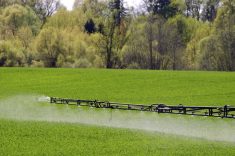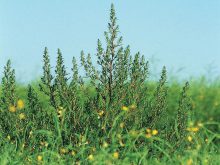Wheat sales are expected to soon resume to Japan and South Korea.
Both nations suspended Canadian wheat imports following the June 15 announcement that Canada had discovered several genetically modified (GM) wheat plants in southern Alberta.
But both are expected to come back to the market shortly, while exports to others won’t be affected, according to Cereals Canada president Cam Dahl.
“We are in a good spot in that we are only going to see (temporary) trade action from Japan and Korea,” Dahl said in an interview Friday.
Read Also

U.S. grains: Soy futures post biggest monthly gain in nearly five years on China trade optimism
U.S. soybean futures climbed to a 15-month high and posted their biggest monthly gain in nearly five years on Friday following a rally fueled by the prospect of revived exports to China.
When GM wheat was first found in the western United States in 2013, Japan suspended U.S. wheat imports for about a month.
“I don’t want to speculate, but I think that might be a valid guideline” for Canada, he said.
“I do expect South Korea to be open in two to three weeks. It’s a 230,000-tonne (a year) market versus a 1.5 million-tonne market (in Japan).”
The GM wheat that didn’t die when sprayed with the non-selective herbicide glyphosate was found along an isolated oil platform access road in southern Alberta last summer. It contained a Monsanto trait (CP4 EPSPS) conferring glyphosate resistance, a Monsanto official said last week.
The same trait has been used in canola, soybeans and corn for 20 years and is deemed safe by the Canadian Food Inspection Agency (CFIA).
Although CFIA doesn’t know the name of the GM wheat, through DNA fingerprinting it has determined it’s not a Canadian variety. Based on that, and extensive testing, CFIA said the GM wheat hasn’t entered Canada’s commercial wheat handling or seed system. But since no GM wheat is authorized in Canada, or elsewhere, for commercial production, there’s zero tolerance in wheat exports.
Many unanswered questions remain.
And in what’s expected to be a surprise to many, CFIA confirmed that confined field tests of GM wheat didn’t stop when Monsanto shelved its GM wheat research in 2004.
“In answer to your question, all wheat trials conducted in the 2017 confined research field trial season contained genetically modified wheat,” CFIA said in an email last week. “Trait objectives in these trials included herbicide tolerance, yield increase, fungal resistance, and selectable markers.”
The National Farmers Union’s seed committee chair, Terry Boehm, is among the surprised.
“I thought there might be laboratory tests (of GM wheat in Canada), but I thought in-field test plots, that was the end of it (in 2004), but I was mistaken,” the Colonsay, Sask., farmer said in an interview Thursday.
That prompted the National Farmers Union (NFU) to ask CFIA to ban “open air” testing of GM wheat and to reveal where it is and was tested, “so that farmers and other Canadians can be on the lookout for escapes, and if found, assist in eradicating them.”
“As the market harm implications are so great and the demand or interest in such a product is nil, we just don’t see why there should be open-air tests conducted at all on GM wheat,” Boehm said.
The federal New Democrats last week said they would call for “urgent hearings” on the matter at the House of Commons’ agriculture and agri-food committee.
“After months of challenges getting their product to market, Canadian wheat farmers are facing yet another obstacle. Canadians deserve to know more about this,” NDP ag critic Alistair MacGregor said June 15.
‘Good feedback’
Asked if Cereals Canada supports banning confined field trails for GM wheat, Dahl said that’s a question for another time.
“My focus in the next while is really on our markets… and we keep our markets open and we get Japan opened up as quickly as possible.”
Officials from Japan’s ministry of agriculture, forestry and fisheries (MAFF) were in Canada last week reviewing CFIA’s procedures, including the test it developed for wheat buyers to check Canadian wheat for the GM event, Dahl said.
They also met with the Canadian Grain Commission (CGC) to see the process it developed to identify the GM wheat, as well as Cereals Canada.
“I believe that Canada has affectively answered the questions they had,” Dahl said.
Although MAFF officials are doing the research and preparing a report, the decision to resume Canadian wheat imports rests with Japan’s ministry of health, he said.
While other Canadian wheat customers are following the GM wheat discovery, none are contemplating suspending Canadian wheat imports, Dahl said.
“I think we will be OK in the EU (European Union),” he said. “They are not about to take trade action. So that is a very positive. Of course they are going to be testing and they will be enforcing the zero tolerance for unapproved events. They appear to be accepting the process that has been carried out here in Canada so that’s very positive.
“We’re getting good feedback from some of the other large markets. Indonesia would be an example, where again they are looking at the processes the that CFIA and CGC have carried out on their inspections and are accepting that.”
Wheat sales will also continue uninterrupted to the U.S.
“We are very much in the same boat, as it were, with the U.S.,” Dahl said alluding to small amounts of GM wheat being discovered in Oregon in 2013, and Montana and Washington in 2014 and 2016 respectively.
Surprisingly, Canada’s GM wheat is different than that found in the U.S.
What’s also odd, Monsanto Canada spokesperson Trish Jordan said, is that the CP4 EPSPS “event” found in the Alberta wheat was dropped by Monsanto in 2000 in favour of two other “events” it was planning to commercialize.
It might also seem strange that CFIA hasn’t identified the wheat the event was found in. But former University of Manitoba weed scientist Rene Van Acker said it’s likely a non-Canadian wheat Monsanto used during its early development of Roundup Ready wheat.
— Allan Dawson is a reporter for the Manitoba Co-operator at Miami, Man. Follow him at @allanreporter on Twitter.













